[HTML1]
Given Nintendo's recent struggles, it's easy to forget that the Kyoto-based company ruled the video game world as recently as 2011. Thanks to the Wii's intuitive motion control system, which allowed players to control games with gestures instead button presses, in the mid 2000's, practically everyone was playing video games. The Wii might not have been the best system for so-called hardcore gamers, but boy, did that system sell.
And yet, it almost didn't happen. According to the latest entry in the Did You Know Gaming? webseries, the motion control technology that made the Wii a global hit could've gone to Microsoft or Sony before Nintendo even got their hands on it - and Nintendo almost turned it down, too.
The story begins as back in 1989, when an entrepreneur and amateur pilot named Tom Quinn came up with a motion controller designed to make airplanes easier to fly. After ten years of legal wrangling, Quinn patented his invention - specifically, a motion control device "that converted any physical motions in the real world to linear motions on a screen" - founded Gyration, and started shopping the tech around.
The aerospace industry wasn't interested in Quinn's device, so the inventor turned his attention towards video games. Quinn approached Microsoft in 2001, just before the original Xbox launched. Reportedly, Microsoft CEO Steve Balmer loved the idea; however, the Xbox team laughed Quinn out of the building. Ultimately, Microsoft passed.
Quinn talked to Sony next. He scheduled an interview with Sony Computer Entertainment president and "father of PlayStation" Ken Kutaragi, who seemed interested in the device - if the controllers could be manufactured for fifty cents or less. They could not. Finally, Quinn turned to Nintendo. According to Quinn, during his presentation Nintendo executives started arguing. Suddenly, Nintendo Chairman Atsushi Asada interrupted, and that was it. Quinn and Gyration were in business.
Nintendo commissioned a prototype from Gyration, with a mandate to make sure that the controller hewed close to the GameCube's button layout. Gyration and Bridge Design developed a controller that looked like a traditional gamepad, but split apart in the middle; this eventually turned into the two piece nunchuk and Wiimote combo that Nintendo fans came to know and love (or at least tolerate).
As most fans know, in the wake of the Wii's success both Microsoft and Sony scrambled to come up with their own motion control solutions. Microsoft's peripheral-free motion sensing hardware, the Kinect, failed to catch on in both of its iterations, while Sony's Move looks like it'll be an integral piece of the company's upcoming Morpheus virtual reality system.
Of course, even with motion controls, Nintendo's fortunes didn't last, and the company's revenue took a nosedive after 2011. Recently, the company posted a profit for the first time in four years, thanks in large part to another gimmicky peripheral: the amiibo, Nintendo's line of plastic figurines that interact with video games via an NFC reader.
Source: Did You Know Gaming?

